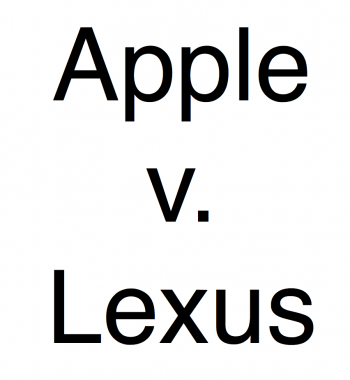 The fanfare surrounding Apple exploded to new levels two weeks ago as we learned that the iPhone maker may enter the automobile business. The Wall Street Journal reported that CEO Tim Cook has hired away top auto executives from Mercedes and Ford and is running a secret car team that may number up to 1,000 employees. Apple, apparently, doesn’t want to let Google, with its driverless car program, or Tesla, the auto darling of the moment, have all the fun. Or, another rumor goes, maybe Apple plans to buy Tesla — for $75 billion. Who knows. Odds are Apple will never build cars. Perhaps Apple is mostly targeting electronics, software, and content in the new and very large “connected car” world.
The fanfare surrounding Apple exploded to new levels two weeks ago as we learned that the iPhone maker may enter the automobile business. The Wall Street Journal reported that CEO Tim Cook has hired away top auto executives from Mercedes and Ford and is running a secret car team that may number up to 1,000 employees. Apple, apparently, doesn’t want to let Google, with its driverless car program, or Tesla, the auto darling of the moment, have all the fun. Or, another rumor goes, maybe Apple plans to buy Tesla — for $75 billion. Who knows. Odds are Apple will never build cars. Perhaps Apple is mostly targeting electronics, software, and content in the new and very large “connected car” world.
Whatever the case, its not difficult to imagine Apple’s iOS, its apps, its icons, and its designs seeping into more and more devices, from smart-watches to smart-homes to connected cars.
Which gets us to the point of this post . . .
There’s a big oral argument today. No, not the health care hearing at the Supreme Court. Today is the latest round of the four-years patent war between Apple and Samsung. The two smartphone titans have been suing each other all over the world, but the cases have reduced to a couple remaining skirmishes in American courts.
While not the focus of today’s argument, the highest profile issue remains unresolved. Last year a jury found Samsung infringed three fairly minor Apple design patents and awarded Apple $930 million — a huge number considering the nature and consequence of the patents in question. Among other legal arguments at issue is a quirk of patent law, dating to 1887, which says an infringer is liable for its “total profit.” But as we’ve previously explained, in today’s market of hypercomplex products, this rule is perverting rationality.
The question is whether the remedy in these cases — the award to the plaintiff of the total profits earned by the defendant’s product — makes any sense in the modern world.
A smartphone is a complex integration of thousands of hardware and software technologies, manufacturing processes, aesthetic designs and concepts. These components may each be patented, or licensed, or not at all, by any number of firms. A smartphone, by one estimate, may contain up to 250,000 patents. Does a minor design patent comprising a tiny fraction of a product’s overall makeup drive the purchase decision? If company A’s product contains one infringing component among many thousands, even if it has no knowledge or intent to infringe, and even if the patent should never have been issued, does it make sense that company B gets all company A’s profits?
There are good reasons to think a fair reading gives a much saner result:
To see why the phrase should be interpreted in a common sense way, consider an alternative plain reading. Why couldn’t “total profit,” for example, mean the entire profit of the firm, including profits derived from unrelated products?
Does anyone think this is the meaning of the law? No. Among other common sense readings, the phrase “to the extent” is a modifier that can easily be read to limit the award in proportion to the severity of the infringement. An additional consideration is that many design patents better resemble trademarks and copyrights, and in fact trademark and copyright law (although imperfect themselves) often provide for more common sense remedies.
Imagine, however, if the reading of the 1887 law that yielded the $930-million award is upheld. Several years from now, Apple’s iOS is installed in Chevrolets and BMWs. But Ford and Lexus are using distinct software that in some way resembles Apple’s. Apple sues Ford and Lexus for a tiny graphical icon containing a bevel that could only have originated in the mind of Sir Johnny Ive. Could Apple be awarded all of Ford’s or Lexus’s profits?
Absurd? Yes. But that is the logical extension of the overly-expansive “total profits” reading.
In the last few years, the Supreme Court has reined in software patents in a hugely constructive way. A common sense ruling here would be one more step forward on the path to patent sanity.

